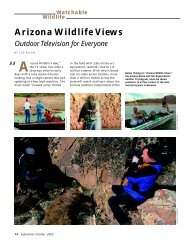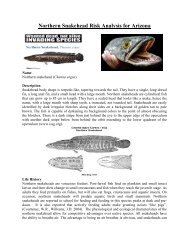7-12 - Arizona Game and Fish Department
7-12 - Arizona Game and Fish Department
7-12 - Arizona Game and Fish Department
Create successful ePaper yourself
Turn your PDF publications into a flip-book with our unique Google optimized e-Paper software.
®<br />
7-<strong>12</strong> Published by the <strong>Arizona</strong> <strong>Game</strong> & <strong>Fish</strong> <strong>Department</strong> - Education Branch <strong>and</strong> the Heritage Fund Number 4<br />
Desert Plant Adaptations<br />
Plants that live in the desert have adapted to conditions<br />
such as lack of moisture, unrestricted sunlight <strong>and</strong> in<br />
many cases, high temperatures. Even though these<br />
conditions may seem harsh to us, many plants not only<br />
survive but thrive <strong>and</strong> reproduce. How do plants<br />
accomplish this<br />
There are three main strategies for desert survival.<br />
Some desert plants may even use more than one of<br />
these strategies. The first is the ability of many plants<br />
(<strong>and</strong> not only desert plants) to store water. This is<br />
called succulence. Succulent plants store water in<br />
fleshy leaves, stems or even roots. Examples of succulent<br />
desert plants include cacti <strong>and</strong> agave. In general,<br />
succulent plants have shallow roots, can begin growth<br />
within 24 to 48 hours of rainfall, <strong>and</strong> use crassulacean<br />
acid metabolism (CAM).<br />
Shallow roots allow plants to quickly absorb any<br />
moisture, even moisture in the form of dew. Plants with<br />
shallow roots can even utilize some of the water from a<br />
torrential rainstorm, even though most is lost to runoff.<br />
The best example of a plant that begins noticeable<br />
growth within 24 to 48 hours of rainfall is the ocotillo.<br />
For most of the year, ocotillo look like a bunch of dead,<br />
thorny branches sticking in the ground. But after the<br />
first really good rainstorm, ocotillo begin to produce<br />
leaves. The leaves begin photosynthesis immediately, to<br />
produce food that the ocotillo can store for later use.<br />
Once the desert begins to dry out again, the ocotillo<br />
drops its leaves. Leaves tend to leak moisture, so by<br />
dropping leaves the plant retains moisture. By growing<br />
only when water is available, a plant saves its resources<br />
until the conditions are right for it to grow.<br />
Crassulacean acid metabolism (CAM) is a type of<br />
photosynthesis that many desert plants use to make<br />
food during the day without losing much water. Lets<br />
begin at the beginning. Photosynthesis occurs in all<br />
plants. It is the process that plants use to make food<br />
from sunlight, water <strong>and</strong> CO 2<br />
(carbon dioxide). Plants<br />
also have little microscopic pores, called stomata, in<br />
their leaves that allow for the passage of CO 2<br />
<strong>and</strong> O 2<br />
(oxygen). Unfortunately, when stomata open to allow<br />
CO 2<br />
in, water can escape, especially in the heat of the<br />
day. So, PROBLEM 1 - How do plants allow CO 2<br />
in<br />
<strong>and</strong> avoid losing water ANSWER 1 - Plants open<br />
stomata at night when temperatures are cooler.<br />
PROBLEM 2 - If plants take in CO 2<br />
at night, how do<br />
they photosynthesize without sunlight ANSWER 2 -<br />
Desert plants store the CO 2<br />
in the form of crassulacean<br />
acid. As a new day begins <strong>and</strong> temperatures rise, the<br />
crassulacean acid is changed back into CO 2<br />
. It can then<br />
be used in photosynthesis.<br />
The second strategy for desert survival for some plants<br />
is called drought dormancy or drought deciduous.<br />
These plants survive periods of drought by conserving<br />
water through reduced metabolism <strong>and</strong> dropping their<br />
leaves. Reduced metabolism is also called “idling<br />
metabolism.” Metabolism is the process of maintaining<br />
life through chemical <strong>and</strong> physical means. Thus the<br />
plant does not completely shut down, but greatly slows<br />
down its metabolism by recycling carbon dioxide <strong>and</strong><br />
using stored water. The “idling metabolism” is just<br />
barely enough to keep the plant alive. In this manner,<br />
the plant does not have to start its metabolism up again<br />
from scratch when the conditions are just right for<br />
growth <strong>and</strong> reproduction. Think of it this way: Two<br />
cars come to a red stop light. Both stop. One car turns<br />
off its engine, while the other just idles. The light turns<br />
green. The car that was just idling can now go. The<br />
other car has to turn on its engine first, warm up <strong>and</strong><br />
then go. If these cars were desert plants, the idling plant<br />
would be able to use the rainfall <strong>and</strong> begin growing<br />
before the other plant. This little bit of an edge may be<br />
all that is needed for the one plant to survive while the<br />
other died.<br />
Desert plants will also drop their leaves during drought<br />
or times of excessive heat. Examples include mesquite,<br />
acacia, palo verde <strong>and</strong> ironwood trees, creosote <strong>and</strong><br />
ocotillo. Remember, leaves are leaky. They can lose<br />
water through stomata. By dropping leaves the plant is<br />
conserving water. Water can no longer escape through<br />
the stomata. But then, how do plants photosynthesis
WILD Kids: 7-<strong>12</strong> <strong>Arizona</strong> <strong>Game</strong> & <strong>Fish</strong> - Education Branch <strong>and</strong> the Heritage Fund Number 4<br />
without leaves Some do not, but others do. Look<br />
carefully at a palo verde tree. What does its name mean<br />
in English Palo verde trees have the mechanisms for<br />
photosynthesis in their bark (making the bark look<br />
green!). Thus they do not need leaves to photosynthesis,<br />
they can photosynthesis with their green bark. Can<br />
you think of other examples<br />
The third type of desert survival strategy that plants use<br />
is called drought avoidance. There are two kind of<br />
drought avoidance. The first is used by annual plants -<br />
plants that live for only one season. These desert plants<br />
dry up <strong>and</strong> die during drought but store moisture, oil,<br />
fat, sugar <strong>and</strong> protein in seeds. The seeds are protected<br />
by a thick, almost waterproof coating. This coating may<br />
contain “anti-germination” chemicals. These chemicals<br />
do not allow the plant to germinate as long as they are<br />
present in the seed coat. But the chemicals can be<br />
washed out by rainfall. Thus, if there is enough water to<br />
wash out the chemicals, there will probably be enough<br />
water for the seed to germinate, mature, reproduce <strong>and</strong><br />
make new seeds before the moisture is gone.<br />
Another type of drought avoidance is used by plants<br />
with tap roots. Tap roots are extra long roots that can<br />
grow down to the water table underground. There the<br />
roots have an almost constant source of water. This<br />
allows the plants to stay green <strong>and</strong> growing through the<br />
long hot <strong>and</strong> dry season. Mesquite trees are a good<br />
example of a plant with a tap root. The average length<br />
of the tap root on a mesquite tree is 60 feet!<br />
There are other ways in which plants retain moisture in<br />
the desert. Some plants have waxy or oily leaves (creosote<br />
<strong>and</strong> jojoba). The wax <strong>and</strong> oil prevents water from<br />
escaping through the stomates. Wax <strong>and</strong> oil are also<br />
somewhat shiny, reflecting light <strong>and</strong> reducing the<br />
temperature of the leaves. Cooler leaves lose less water.<br />
Other plants have “hairy” leaves. These hairs are not<br />
true hairs like on mammals but a extension of the<br />
epidermis (skin or upper most surface). The hair<br />
shades the surface of the leaf, reducing the temperature<br />
of the leaf <strong>and</strong> thus water loss. Other plants have very<br />
small leaves or no leaves at all. Cacti have no leaves!<br />
Small leaves means there is less surface from which<br />
water can evaporate. Even spines can help the plant<br />
retain water.<br />
Activity I: Shade <strong>and</strong> Spines<br />
This is an outside activity so get permission from your<br />
teacher before you do it. You will need a pencil, paper,<br />
ruler, a spiny cactus <strong>and</strong> maybe gloves.<br />
Find a cactus that is small enough for you to measure<br />
<strong>and</strong> not shaded by other plants. One day go out <strong>and</strong><br />
measure the total surface area of the cactus. If it is a<br />
prickly pear-type cactus measure both the front <strong>and</strong><br />
back sides of each pad. If it is a barrel-type cactus,<br />
measure the pleats in <strong>and</strong> out <strong>and</strong> its height.<br />
The next day go back to your plant around mid-morning<br />
or mid-afternoon. Now comes the tricky part.<br />
Measure all the area that is in shade. Make note of the<br />
amount of shade due to spines <strong>and</strong> the amount due to<br />
another part of the cactus shading itself.<br />
How much of the plant is in shade What percentage is<br />
due to spines Do spines substantially shade your cactus<br />
or others in your class If your cactus has pleats, what<br />
percentage of shading is due to pleats alone Spines<br />
Both<br />
Activity II: Evaporation<br />
This is an indoor activity, but you need a window. You<br />
could even do this at home <strong>and</strong> report your findings<br />
back to your class. You will need three glasses that are<br />
exactly the same, water, cooking oil, <strong>and</strong> hair from a<br />
hair brush.<br />
First, in the morning, fill each glass with the same exact<br />
amount of water. Mark the glasses on the outside at<br />
the water level. To one glass, add 1 tablespoon of<br />
cooking oil. To the second, add hair from your hair<br />
brush (or your moms, sisters, friends, etc.). To the<br />
third, add nothing. Note the temperature near the<br />
window. Set all three glasses on the window sill <strong>and</strong><br />
leave them there all day.<br />
After 24 hours, mark on the outside of the glasses<br />
where the new water line is. What volume, if any, of<br />
water was lost Which glass lost the most water Why<br />
Which glass lost the least water Why<br />
Repeat this experiment another day when it is warmer<br />
or cooler. Does temperature affect the outcome Why<br />
or why not
















